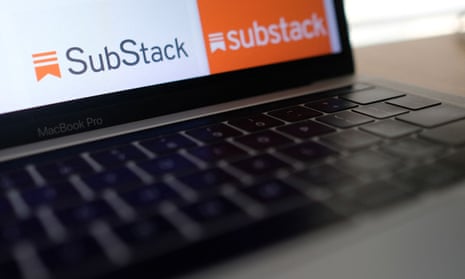A group of vaccine-sceptic writers are generating revenues of at least $2.5m (£1.85m) a year from publishing newsletters for tens of thousands of followers on the online publishing platform Substack, according to new research.
Prominent figures in the anti-vaccine movement including Dr Joseph Mercola and Alex Berenson have large followings on Substack, which has more than 1 million paying subscribers who sign up for individual newsletters from an array of authors who include novelist Salman Rushdie, the writer musician Patti Smith and former Downing Street adviser Dominic Cummings.
Mercola, a US alternative medicine doctor and prolific producer of anti-vaccine content, and Alex Berenson, a journalist banned from Twitter last year after questioning the efficacy of Covid-19 vaccines, are among five vaccine sceptics on the platform who earn themselves and Substack a minimum of $2.5m a year from their newsletters. Under Substack’s business model, writers keep about 90% of the subscription income, with the platform taking 10% and payment company Stripe charging the writers 3% of their take.
Research by the Center for Countering Digital Hate, a campaign group, showed that Mercola’s newsletters made a minimum of $1m a year from charging subscribers an annual fee of $50, with Berenson making at least $1.2m from charging people $60. Three other vaccine sceptic newsletters, from tech entrepreneur Steven Kirsch, virologist Robert Malone and anonymous writer Eugyppius, generate about $300,000 between them.
Imran Ahmed, chief executive of CCDH, said companies like Substack were under “no obligation” to amplify vaccine scepticism and make money from it. “They could just say no. This isn’t about freedom; this is about profiting from lies … Substack should immediately stop profiting from medical misinformation that can seriously harm readers.”
Newsletters cited by CCDH research include: a piece authored by Mercola headlined “More Children Have Died From Covid Shot Than From Covid”; a Berenson substack questioning whether mRNA vaccines have contributed to, rather than stopped, the spread of Covid; a Kirsch newsletter stating that “vaccines kill more far more people than they might save from Covid”; a newsletter from Malone warning that mRNA vaccines could lead to permanent damage of children’s organs; and a Eugyppius Substack claiming that “vaccines don’t suppress case rates at all.”
A Substack spokesperson referred the Guardian to an essay published on Wednesday by the platform’s co-founders, Chris Best, Hamish McKenzie and Jairaj Sethi, in which they said silencing vaccine sceptics would not work. “As we face growing pressure to censor content published on Substack that to some seems dubious or objectionable, our answer remains the same: we make decisions based on principles not PR, we will defend free expression, and we will stick to our hands-off approach to content moderation,” they said.
Substack’s content guidelines state that “critique and discussion of controversial issues are part of robust discourse, so we work to find a reasonable balance between these two priorities”. The platform bars content that “promotes harmful or illegal activities” but also expects writers to moderate and manage their own communities.
The statement came as Spotify began removing Neil Young’s music after the streaming service refused to take down Joe Rogan’s podcast despite the musician’s objections that it spread vaccine misinformation.
CCDH said the $2.5m was a minimum amount of revenue that vaccine-sceptic writers are generating and that the figure could be as high as $12.5m. Substack does not give exact subscriber numbers for individual newsletter publishers and only reveals followings in broad terms such as “thousands” and “tens of thousands.”
Because Mercola and Berenson have “tens of thousands” of followers, CCDH calculated the lowest estimate of their earnings on the assumption that they had 20,000 each, with Kirsch, Eugyppius and Malone presumed to have a minimum of 2,000 followers owing to Substack stating they have“thousands” of subscribers.
